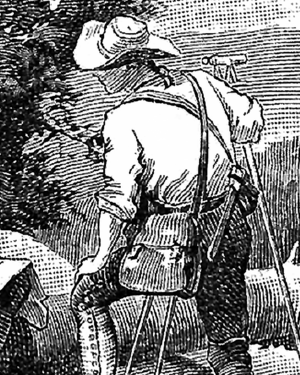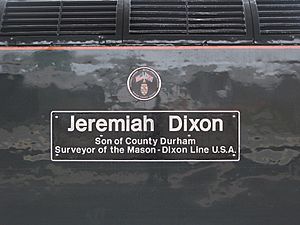Jeremiah Dixon facts for kids
Quick facts for kids
Jeremiah Dixon
|
|
|---|---|

Illustration of Dixon surveying the Mason–Dixon line, 1910
|
|
| Born | 27 July 1733 |
| Died | 22 January 1779 (aged 45) |
| Nationality | Kingdom of Great Britain |
| Known for | Mason–Dixon line |
| Scientific career | |
| Fields | Astronomy, surveying |
| Institutions | Fellow of the Royal Society, 1758 Fellow of the Royal Society of Edinburgh |
| Signature | |
Jeremiah Dixon (born July 27, 1733 – died January 22, 1779) was an English surveyor and astronomer. He is most famous for his work with Charles Mason between 1763 and 1767. Together, they helped create what is now known as the Mason–Dixon line.
Contents
Early Life and Learning
Jeremiah Dixon was born in 1733 in Cockfield, a small town near Bishop Auckland in County Durham, England. He was one of seven children. His father, George Dixon, owned a coal mine.
From a young age, Jeremiah became very interested in astronomy (the study of stars and planets) and mathematics (the study of numbers and shapes). He learned a lot during his time at Barnard Castle. He also met smart people in his area, like the mathematician William Emerson and astronomers John Bird and Thomas Wright.
His Work as a Surveyor and Astronomer
Observing the Transit of Venus
In 1761, the Royal Society (a famous group of scientists) sent Jeremiah Dixon and Charles Mason on an important trip. They were supposed to go to Sumatra to watch a rare event called the transit of Venus. This is when the planet Venus passes directly in front of the Sun.
However, their journey was delayed. Instead, they landed at the Cape of Good Hope in Africa. There, they successfully observed the transit of Venus on June 6, 1761. Later, Dixon went back to the Cape with a special clock to do experiments about gravity.
Mapping the Mason-Dixon Line
In 1763, Dixon and Mason signed an agreement with the owners of Pennsylvania and Maryland. These two American colonies had a big disagreement about where their border was. Dixon and Mason were hired to help solve this problem.
They arrived in Philadelphia in November 1763 and started their important work. They spent several years carefully measuring and marking the boundary. This survey was finished in late 1766.
After completing the border, they stayed to measure a degree of the Earth's meridian (an imaginary line running from north to south) on the Delmarva Peninsula in Maryland. They also took more gravity measurements. Before going back to England in 1768, both men became members of the American Society for Promoting Useful Knowledge in Philadelphia.
Another Trip to Observe Venus
In 1769, Dixon sailed to Norway with another astronomer, William Bayly. Their mission was to observe another transit of Venus. To make sure they didn't miss it due to bad weather, they split up. Dixon went to Hammerfest Island, and Bayly went to North Cape. After returning to England in July, Dixon continued his work as a surveyor in his home area of Durham.
His Personal Life
Jeremiah Dixon never married. He passed away in Cockfield on January 22, 1779. He was buried in an unmarked grave in the Quaker cemetery in Staindrop. He was known to be a Quaker, a member of a religious group.
Jeremiah Dixon's Legacy
The Name "Dixie"
Some people believe that Dixon's name might be where the nickname Dixie came from. This name is often used to refer to the U.S. Southern States. This is interesting because he worked on the northern side of the famous Mason-Dixon line.
In Books and Music
Jeremiah Dixon is one of the two main characters in a 1997 novel called Mason & Dixon by Thomas Pynchon. The song Sailing to Philadelphia by Mark Knopfler also mentions Mason and Dixon. This song was inspired by Pynchon's book.
Honors and Exhibitions
In 2013, an exhibition about Jeremiah Dixon's life and work was held at the Bowes Museum in Barnard Castle, England. It was called Jeremiah Dixon: Scientist, Surveyor and Stargazer.
Also in September 2013, a train engine operating on the Weardale Railway in County Durham was named after Jeremiah Dixon. This locomotive now works in the Willesden area of northwest London.
See also


